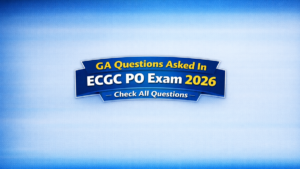IBPS SO Exam is a g and a lot of aspirants are heading towards new hopes with this upcoming opportunity. Thus, the English Language can be an impetus for their success by helping them save crucial time and score good points in lesser time and effort. So, instead of boiling the ocean, try building up a strong vocabulary, an effective knowledge of grammar, and efficient comprehension skills so as to be on the ball to face this particular section. Here is a quiz on English Language being provided by Adda247 to let you practice the best of latest pattern English Questions for upcoming IBPS SO Exam.
Directions (1-5)- Read the following passage and answer the questions as directed.
Reports of traces of the chemical formaldehyde in fish in several States highlight both the uncertainties of science, and the importance of clear risk-communication. In June, the Kerala government found formaldehyde-laced fish being transported into the State. Soon after, The Hindu carried out a joint investigation with the Tamil Nadu Dr. J. Jayalalithaa Fisheries University to look for formaldehyde in Chennai. The study revealed around 5-20 ppm of the chemical in freshwater and marine fish in two of the city’s markets. Next, Goa reported similar findings. But its Food and Drugs Administration later said the levels in Goan samples were on a par with “naturally occurring” formaldehyde in marine fish. This triggered suspicions among residents, who accused the government of playing down the health risk.
The Food Safety and Standards Authority of India has banned formaldehyde in fresh fish, while the International Agency for Research on Cancer labelled the chemical a carcinogen in 2004. The evidence the IARC relied on mainly consists of studies on workers in industries such as printing, textiles and embalming. Such workers inhale formaldehyde fumes, and the studies show high rates of nasopharyngeal and other cancers among them. But there is little evidence that formaldehyde causes cancer when ingested orally. A 1990 study by U.S. researchers estimated that humans consume 11 mg of the chemical through dietary sources every day.
So, why is formaldehyde in fish a problem? For one thing, fresh fish should not have preservatives, and the presence of formaldehyde points to unscrupulous vendors trying to pass off stale catch as recent. Two, the lack of evidence linking ingested formaldehyde with cancer doesn’t necessarily make the chemical safe. At high doses, it causes gastric irritation. Plus, the lack of data could merely mean that not enough people are consuming formaldehyde regularly enough for its carcinogenic effects to show — the absence of evidence is not evidence of absence. There is a third complication. When certain marine fish are improperly frozen during transit, formaldehyde forms in them naturally. But this formaldehyde binds to the tissue, unlike added formaldehyde, which remains free. And so, measuring free formaldehyde versus bound formaldehyde can be one way of distinguishing a contaminant from a naturally occurring chemical. In this context, the Goan government must clarify its claim. Did the Goan FDA measure free formaldehyde or bound formaldehyde? If it measured the sum of both, on what basis did it conclude that the chemical came from natural sources? Some formaldehyde consumption may be unavoidable for fish- lovers, and it may not be a health risk either. But the line between safe and unsafe consumption should be drawn by experts, in a transparent manner. The Goan claim doesn’t meet this criterion. This is why, instead of allaying the fears of consumers, it is stoking them.
Q1. What had triggered suspicions among residents in goa?
High levels of chlorine in fish.
High levels of formaldehyde in marine fish.
Both (a) and (b)
High levels of pollutants in water
None of the above.
Solution:
According to paragraph 1, option (b) is correct.
Q2. Why is formaldehyde in fish a problem?
Fresh fish should not have preservatives, and the presence of formaldehyde points to unscrupulous vendors trying to pass off stale catch as recent.
At high doses, it causes gastric irritation.
The lack of evidence linking ingested formaldehyde with cancer doesn’t necessarily make the chemical safe.
None of the above
All of the above
Solution:
According to paragraph 3, option (e) is correct.
Q3. Which three industries did the workers who were studied for the IARC research belonged to?
Printing, textiles and marketing.
Textiles, cotton and steel.
None of the above
Printing, textiles and embalming
Embalming, coal and mining
Solution:
According to paragraph 2, option (d) is correct.
Q4. Which word is SIMILAR to the word ‘ingested’ given in bold?
Build
Throw
Devour
Destruction
None of the above
Solution:
Option (c) i.e. ‘devour’ means the same as ‘ingested’. ‘Ingested’ means to take, as food, into the body.
Q5. Which word is OPPOSITE to the word ‘unavoidable’ given in bold?
Obligatory
Escapable
Inevitable
Inevasible
None of the above
Solution:
Option (b) i.e. ‘escapable’ is opposite in meaning to ‘unavoidable’ which means something that cannot be avoided.
Directions (6-10): In each of the questions given below an incomplete sentence is given which must be filled/completed with one of the sentences/words given below .i.e. one of the sentences/words can be fit into the given blanks. Choose the correct option and complete the given sentences. If none of the given alternatives is appropriate to fill the blank, choose option (e) i.e. “none of these” as your answer choice.
Q6. For a party that had appeared to be lost in the political wilderness over the past few years, the Congress ----------------------------------- following the results in the recent round of Assembly elections.
has plenty to cheer about
has plenty in cheer about
have plenty to cheer about
has plenty to cheering for
None of these
Solution:
“has plenty to cheer about” is grammatically and contextually correct here.
Q7. If the Congress ----------------------------------- in Rajasthan and Madhya Pradesh, it was because independents and smaller parties registered a few surprise victories.
struggling to breast the tape
struggle to breasting the tape
struggled in breast the tape
struggled to breast the tape
None of these
Solution:
“struggled to breast the tape” is grammatically and contextually correct here.
Q8. If the results are interpreted as pointers on how the 2019 election will play out, then the Congress ------------------------------------- it would like to be.
might be still short of where
may be still short of which
may be still short of where
may still short for where
None of these
Solution:
“may be still short of where” is grammatically and contextually correct here.
Q9. The BJP will be worried that the results will encourage the Congress and the BSP to ----------------- .
came together in an electoral embrace
comes together in an electoral embrace
come together in a electoral embrace
come together in an electoral embrace
None of these
Solution:
“come together in an electoral embrace” is grammatically and contextually correct here.
Q10. A potent mix of rural distress and urban angst seem to have ------------------------------- BJP’s support base.
contribute to the erosion in the
contribute in the erosion in the
contributed to the erosion in the
contributed for the erosion in the
None of these
Solution:
“contributed to the erosion in the” is grammatically and contextually correct here.
Directions (11-15): Rearrange the following five sentences (A), (B), (C), (D) and (E) in the proper sequence to form a meaningful paragraph and then answer the questions given below.
(A) The reconstruction of history by post-revolutionary science texts involves more than a multiplication of historical misconstructions.
(B) Because they aim quickly to acquaint the student with what the contemporary scientific community thinks it knows, textbooks treat the various experiments, concepts, laws and theories of the current normal science as separately and as nearly seriatim as possible.
(C) Those misconstructions render revolutions invisible; the arrangement of the still visible material in science texts implies a process that, if it existed, would deny revolutions a function.
(D) But when combined with the generally unhistorical air of science writing and with the occasional systematic misconstruction, one impression is likely to follow.
(E) As pedagogy this technique of presentation is unexceptionable.
Q11. Which is the LAST sentence after rearrangement?
D
E
B
A
C
Solution:
The correct sequence is ACBED.
The reconstruction of history by post-revolutionary science texts involves more than a multiplication of historical misconstructions. Those misconstructions render revolutions invisible; the arrangement of the still visible material in science texts implies a process that, if it existed, would deny revolutions a function. Because they aim quickly to acquaint the student with what the contemporary scientific community thinks it knows, textbooks treat the various experiments, concepts, laws and theories of the current normal science as separately and as nearly seriatim as possible. As pedagogy this technique of presentation is unexceptionable. But when combined with the generally unhistorical air of science writing and with the occasional systematic misconstruction, one impression is likely to follow.
Q12. Which is the SECOND sentence after rearrangement?
A
D
E
C
B
Solution:
The correct sequence is ACBED.
Q13. Which is the FOURTH sentence after rearrangement?
D
A
E
B
C
Solution:
The correct sequence is ACBED.
Q14. Which is the FIRST sentence after rearrangement?
B
A
D
C
E
Solution:
The correct sequence is ACBED.
Q15. Which is the THIRD sentence after rearrangement?
A
B
C
D
E
Solution:
The correct sequence is ACBED.





 GA Questions Asked In ECGC PO Exam 2026,...
GA Questions Asked In ECGC PO Exam 2026,...
 OICL AO Exam Analysis 2026, 10 January S...
OICL AO Exam Analysis 2026, 10 January S...
 Daily Current Affairs Quiz 10th January,...
Daily Current Affairs Quiz 10th January,...








